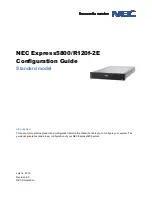
The second method gives the ability to create configurations that enable the library to process commands
from multiple heterogeneous applications (such as a Windows application) and multiple homogeneous
applications (for example, the same application run by several System p servers). See “Advanced library
configuration” on page 55.
Path failover and load balancing
The path failover feature ensures the use of a redundant communication path when the primary path
fails.
Command failures and time outs are costly. You want your library to run smoothly and efficiently. Path
failover capabilities allow the device driver to resend a command to an alternate path. The alternate path
can include another host bus adapter (HBA), Storage Area Network (SAN), or library control path drive.
The device driver initiates error recovery and continues the operation on the alternate path without
interrupting the application.
Path failover and load balancing are built-in features that are enabled by using a purchased license. The
path failover feature can be ordered from the factory, or you can order it as a field upgrade. The path
failover feature is activated on the Management GUI. To order features, contact your Sales Representative
or Business Partner.
Two types of path failover capabilities exist: control path failover (CPF) and data path failover (DPF). Control
refers to the command set that controls the library (the
SCSI Medium Changer
command set on LUN 1 of
the tape drives). Data refers to the command set that carries the customer data to and from the tape
drives (the SCSI-3 Stream Commands (SSC) device on LUN 0 of the tape drives). Path failover means the
same thing in both. Path failover is where redundancy is in the path from the application to the intended
target (the library accessor or the drive mechanism), the device driver transparently fails over to another
path in response to a break in the active path.
Both types of failover include host-side failover when configured with multiple HBA ports into a switch.
But CPF includes target-side failover through the control paths that are enabled on more than one tape
drive. DPF includes target-side failover for the dual-ported tape drives that are supported by the library.
DPF includes load balancing of the HBAs because the channel is a data-intensive path (the control path
carries little data, so load balancing is not an issue). The dynamic load balancing support optimizes
resources for devices that have physical connections to multiple HBAs in the same machine. When an
application opens a device where multiple HBA paths are configured, the device driver determines which
path has the HBA with the lowest usage and assigns that path to the application. When another
application opens a different device with multiple HBA paths, the device driver again determines the
path with the lowest HBA usage and assigns that path to the second application. The device driver
updates the usage on the HBA assigned to the application when the device is closed. Dynamic load
balancing uses all HBAs whenever possible and balances the load between them to optimize the
resources in the machine.
Both CPF and DPF require the use of the current device driver. They are supported exclusively with
products that bear the Dell logo on the operating systems that is indicated in Table 15.
Table 15 summarizes the differences between CPF, DPF, and load balancing.
Table 15. Differences between CPF and DPF
Characteristic
CPF
DPF and Load Balancing
Device type
SMC
1
SSC
2
LUN
3
LUN 1
LUN 0
Host-side failover
Yes
Yes
6
Target-side failover
Yes
6
Yes
6
18
Dell EMC ML3 Tape Library: User's Guide
Summary of Contents for 3555-E3A
Page 1: ...Dell EMC ML3 Tape Library User s Guide ...
Page 2: ......
Page 4: ...iv Dell EMC ML3 Tape Library User s Guide ...
Page 8: ...viii Dell EMC ML3 Tape Library User s Guide ...
Page 10: ...x Dell EMC ML3 Tape Library User s Guide ...
Page 20: ...xx Dell EMC ML3 Tape Library User s Guide ...
Page 22: ...xxii Dell EMC ML3 Tape Library User s Guide ...
Page 44: ...22 Dell EMC ML3 Tape Library User s Guide ...
Page 54: ...32 Dell EMC ML3 Tape Library User s Guide ...
Page 94: ...72 Dell EMC ML3 Tape Library User s Guide ...
Page 126: ...104 Dell EMC ML3 Tape Library User s Guide ...
Page 153: ...Figure 81 Unlocked spooling mechanism enlarged view Upgrading and servicing 131 ...
Page 164: ...142 Dell EMC ML3 Tape Library User s Guide ...
Page 174: ...152 Dell EMC ML3 Tape Library User s Guide ...
Page 176: ...154 Dell EMC ML3 Tape Library User s Guide ...
Page 195: ...XRA External register address register Glossary 173 ...
Page 196: ...174 Dell EMC ML3 Tape Library User s Guide ...
Page 200: ...178 Dell EMC ML3 Tape Library User s Guide ...
Page 201: ......
Page 202: ...Printed in USA ...
















































